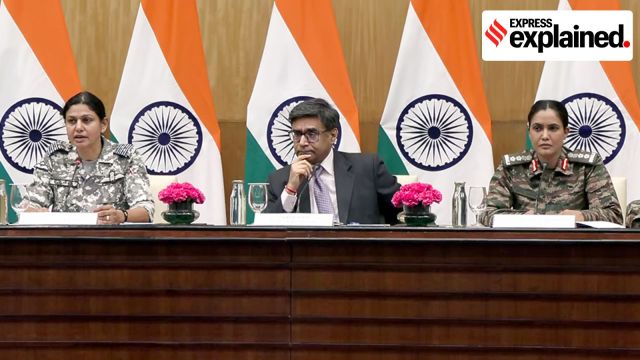A preliminary probe into the debris after Pakistan’s attempt to breach the northern and western fronts Thursday night suggests that the drones used by Pakistan are of Turkish origin, the Songar armed drone system, the government said Friday.
Briefing reporters, Wing Commander Vyomika Singh and Col Sofiya Qureshi said that along the international border and Line of Control, drone intrusions were attempted from Siachen to Sir Creek at 36 locations with approximately 300-400 drones. Forensic examination of the drone debris is being undertaken. Preliminary reports suggest they are Asisguard’s Songar drone from Turkey.

Songar is an armed drone system designed and manufactured by Asisguard, part of Asis Electronics and Information Systems, to serve as a force-multiplier for low-intensity conflicts.
It is the first domestic armed drone system to be operated by the Turkish Armed Forces (TAF). It is Turkey’s first indigenous drone armed with a machine gun.
India naming Turkey’s drones is significant, since Pakistan is understood to have a strong arsenal of Chinese defence equipment as well.
The fact that Pakistan has these drones is part of its deep and robust defence cooperation with Turkey. Indeed, Turkish President Recep Tayyip Erdogan spoke by phone on May 7 with Pakistan’s Prime Minister Shehbaz Sharif to convey his solidarity after India hit nine terror sites in Pakistan and PoK.
During the call, Erdogan had told Sharif that Turkey supported what he called Pakistan’s “calm and restrained policies” in the crisis, his office said in a statement.
Story continues below this ad
Erdogan also said he found “appropriate” Islamabad’s call for an investigation into the Pahalgam terror attack. India had rejected that call for an international probe.
Incidentally, Sharif was in Turkey when the Pahalgam terror attack happened on April 22. He met Erdogan at that time and discussed defence cooperation.
The defence partnership between Turkey and Pakistan has deepened in recent years through institutional mechanisms and increasing joint exercises. Major defence deals with technology transfer provisions have bolstered Pakistan’s capabilities.
The Pakistan Air Force (PAF) has been receiving the delivery F-16 Fighting Falcon jets from Turkish Aerospace Industries (TAI) in Ankara.
Story continues below this ad
Pakistan’s National Aerospace Science and Technology Park (NASTP), inaugurated in August 2023, has entered into a collaboration agreement with Turkish drone manufacturer Baykar for research and development.
According to the Stockholm International Peace Research Institute (SIPRI)’s Trade Register, Pakistan ordered three Bayraktar TB-2 armed UAV from Turkey in 2021 and received them in 2022.
In Songar’s case, according to the company’s website, “the aerial drone has a width of 145 cm from rotor to rotor and height of 70 cm. It has a maximum take-off weight (MTOW) of 45 kg. The portable unmanned aerial system (UAS) can be easily deployed by infantry units and small security elements. It is capable of conducting operations during day and night.”
It said that the drone system’s machine gun can fire NATO class 5.56x45mm rounds. It has a maximum ammunition load capacity of 200 rounds and can also support single and 15-round burst modes.
Story continues below this ad
The armed drone is offered with various sub systems including a multi-rotor drone platform, gun stabilization system, drone mounted machine gun, and a ground control station.
The Songar drone system is installed with two cameras, including a pilot camera with 10x zoom and a gun-mounted camera.
The cameras are capable of transmitting video and real-time images. The night sensors allow the drone to perform operations within a range of 10 km.
The camera systems are capable of performing real-time video transfer as well as video and data recording for post-mission analysis.
Story continues below this ad
The armed drone uses both GPS and GLONASS navigation systems for communications during operations, the company’s website said.
It also said the maximum operational range of the unmanned vehicle is 3 km. It can hit targets within a 15-cm area from a distance of 200 m. The drone can ascend to an altitude of up to 2,800 m at mean sea level and 400 m above ground level.








































